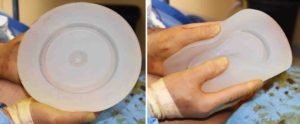Background: Implants are the alternative to fat grafting to the buttocks (Brazilian Butt Lift or BBL) when the patient either does not have enough fat to harvest or has had a failed BBL procedure. When placing buttock implants the decisions to be made are pocket location and implant size…although the former controls the latter. Meaning that beyond a certain implant’s size (greater than 350cc – 400ccs) only a subfascial pocket location can be used.
Subfascial buttock implant placement has several advantages including no disruption of the gluteus maximus muscle and the ability to place larger buttock implant sizes. Its disadvantages are a higher risk of postoperative fluid collection (seroma), more visible implant show and inferior displacement or sagging. While such potential complications can not be completely eliminated, one does wonder if they could be reduced by innovations in implant design.
The problem with implant show in the subfascial position is that the typical edging on buttock implants is rounded. With a surrounding encapsulating scar that develops its eventual tightening around the implant with advanced healing, this implant design feature allows for a visible outline of the implant to be seen in patients with thinner buttock soft tissues. Such implants should have feather edging to limit the development of this aesthetic problem
Implants in the subfascial position, however, are best known for their potential to migrate and develop implant malposition. This does not occur in the intramuscular position because of the tighter tissue pocket from the thick muscle in a deeper pocket. Tissue ingrowth into the implant may help limit this problem and the more obvious solution would be texturing of the implant’s surface. But this also makes the implant such harder to introduce and position into the pocket. Other innovations await to be introduced.


Whether this new innovative buttock implant design will permit enough tissue ingrowth to prevent migration/displacement awaits long-term followup in more cases, it is clear that the design makes for easier implant introduction through the incision. The decreased internal material allows for it to be folded in a tighter roll.
Case Highlights:
1) Large volume buttock implants (750ccs or greater) must be made custom for each patient.
2) Subfascial buttock implants are best made with feather edging to prevent eventual implant edge show.
3) To help prevent sagging and long-term displacement an innovative racetrack design is placed on the bottom edge of the custom buttock implants.
Dr. Barry Eppley
Indianapolis, Indiana



